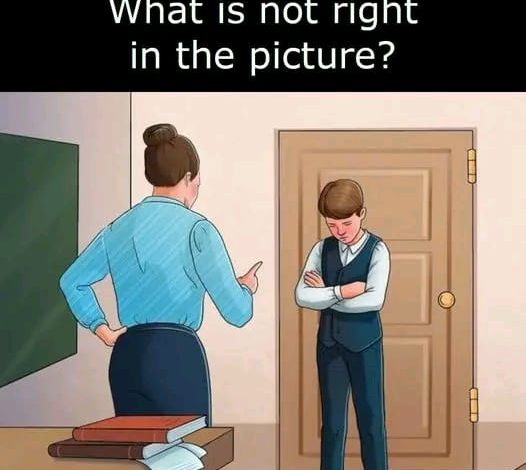The Subtle Details: Unpacking Classroom Dynamics in Modern Education

ADVERTISEMENT
The Subtle Details: Unpacking Classroom Dynamics in Modern Education
Introduction:
The classroom is a complex environment where subtle details can significantly influence the learning experience. The image prompts viewers to identify what might be “not right” in a seemingly ordinary classroom interaction, highlighting the nuances of educational settings and the interactions that define them. This exploration delves into the roles and responsibilities of educators and students, emphasizing the importance of observing and refining everyday practices within educational institutions.
Body: Analyzing the Scene: The image shows a young student standing by the door, facing a teacher who appears to be addressing him with a stern posture. The setting is typical of a classroom environment, complete with educational materials like books and notebooks. However, a closer look suggests a few anomalies or points of discussion:
- Teacher’s Posture and Engagement: The teacher’s stance might be seen as confrontational or authoritative, which could affect the student’s receptiveness to feedback. The physical setup of the interaction, with the teacher elevated and the student near the exit, symbolizes a potential power imbalance.
- Student’s Body Language: The student’s arms are crossed, and his head is bowed, indicating feelings of defensiveness or discomfort. This body language might reflect a sense of resignation or conflict, rather than an open dialogue about learning or behavior.
- Environmental Setup: The placement of the student near the classroom door could imply readiness for the student to leave, which may not foster a conducive atmosphere for resolving whatever issue is at hand. It could signify exclusion rather than correction.
Contextualizing Modern Educational Practices: Current educational philosophies often emphasize positive reinforcement, constructive feedback, and the psychological well-being of students. Punitive measures or authoritative stances are increasingly scrutinized for their long-term effectiveness and impact on student engagement and self-esteem. This scene might reflect outdated methods or highlight the need for ongoing teacher training focused on supportive educational practices.
ADVERTISEMENT
Discussion of Teacher-Student Dynamics: Effective education relies on positive relationships between teachers and students. Trust, respect, and open communication are foundational to fostering an environment where students can learn and thrive. The depicted scenario may underscore common challenges in achieving these ideals, especially in situations involving discipline.
Conclusion: While the image invites viewers to critique what might be wrong, it also opens a broader dialogue about the complexities of teacher-student interactions. Each element within a classroom setting—from spatial arrangements to body language and engagement styles—can profoundly influence the educational experience. As educators and administrators continue to adapt to best practices, images like these serve as vital prompts for reflection and improvement in our approach to education.
This discussion not only encourages an examination of the specific scenario depicted but also invites educators, students, and the broader community to consider how best to support effective learning and positive classroom dynamics.




